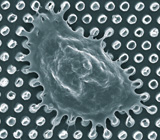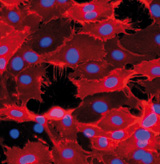Challenge: Colonization of surfaces with biological cells
The colonization of surfaces with biological cells is important in cell culture technology, but also with regard to the ingrowth of prosthetic implants, the development of cell-based implants, or biological test systems in which, for example, the exchange of substances via the endothelial layer of a blood vessel is to be investigated.
 Fraunhofer Institute for Interfacial Engineering and Biotechnology IGB
Fraunhofer Institute for Interfacial Engineering and Biotechnology IGB
